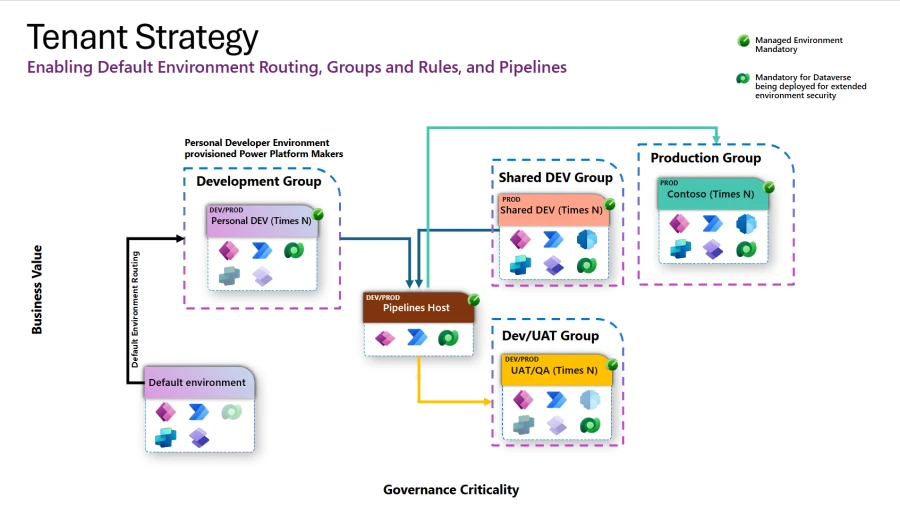
Increase efficiency with Microsoft Power Platform governance features
Preview Microsoft Power Platform environment groups and rules
As organizations expand their Microsoft Power Platform footprint to meet the needs of their users for application modernization and the inclusion of Microsoft Copilot, administrators can utilize premium features such as managed environments to govern at-scale quickly and easily, while increasing visibility and control. However, as more environments are deployed, administrators need a way to streamline governance and ensure consistency.
One of the reasons why Microsoft Power Platform is becoming more popular and widely adopted in organizations is its ability to enable rapid application development and innovation. Microsoft Power Platform allows users of different skill levels to create and customize apps, workflows, chatbots, and reports that suit their business needs, using low-code or no-code tools. Microsoft Power Platform also integrates seamlessly with other Microsoft products, such as Microsoft 365, Microsoft Dynamics 365, Microsoft Azure, and Microsoft Teams, as well as with external data sources and services. By using Microsoft Power Platform, organizations can empower their employees to solve problems, automate processes, and improve efficiency, without compromising security or compliance.
In our effort to increase efficiency and streamline the process of managing Microsoft Power Platform, we’re thrilled to introduce the public preview of Microsoft Power Platform environment groups and rules and the newest capabilities of environment routing.
Explore more about environment groups and rules in the official documentation.
Making governance at-scale even easier
Environment groups empower admins to establish governance policies through customizable rules, ensuring consistency across environments and eliminating chaos. Microsoft Power Platform administrators can create environment groups. These groups serve as holders for related environments. You can use environment groups to organize your environments by department, project, cost center, or any other relevant criteria, offering a systematic way to manage collection of environments in aggregate.
In each environment group, administrators can uniformly apply six key capabilities of managed environments to all associated environments. These include setting sharing restrictions for canvas apps, utilizing AI to generate app and solution summaries, and enforcing best practices with solution checker—eliminating the need for manual solution checking. This initial suite of rules is just the beginning, with plans to expand in the near future, providing Microsoft Power Platform administrators even greater control over their environment groups.
By joining a group, an environment automatically follows all of the group’s rules. You don’t need to set it up manually. This makes sure that all environments in the group are aligned with the basic standards from the start. To ensure that each environment in an environment group maintains the configuration settings determined at the environment group level, the administrators of those single environments within the group will not be able to alter those settings and fall out of compliance with any configured rules.

Why is default environment routing important?
Thanks to environment groups, these environments come preloaded with essential admin settings, including sharing limits and solution-checker, making adoption a breeze for Microsoft Power Platform admins. Previously, new makers had to figure out which environment to work in. With default environment routing, this decision happens automatically. Default environment routing is a feature that automatically directs new makers to their personal developer environments instead of the default environment.
Personal developer environments are individual workspaces, similar to Microsoft OneDrive, where makers can confidently build apps and solutions using Microsoft Dataverse without worrying about others accessing their work, assets, and artifacts. Admins no longer need to be concerned about makers accidentally working in the default environment, where their work might conflict with others.
When combining with environment groups and rules, these environments come preconfigured with environment-level governance settings, including sharing limits and solution checker. This feature helps new makers to avoid confusion and conflicts when working in Microsoft Power Platform and helps admins to manage their environments more easily.
What are the key points to remember?
- Preview feature: Keep in mind that this feature is currently in preview. While it provides early access for feedback, it’s not intended for production use and may change or be discontinued in the future.
- Managed environments: All developer environments created through environment routing are managed environments as are all environments in a group. These environments require premium licenses for running Microsoft Power Platform assets.
- Developer plan: Managed environments are not included as an entitlement in the developer plan, which is a free plan for individual developers to learn and build solutions. Learn more about the Microsoft Power Apps developer plan.

Next steps
Environment groups and rules streamline management with efficient oversight over multiple environments using a centralized, consistent approach. This ensures uniform standards and configurations across all environments, significantly enhancing developer efficiency by providing ready-made, pre-configured environments that eliminate the need for manual setup. Consequently, this uniform governance simplifies administration and reduces overhead, leading to a more efficient development process. We’re excited to see how organizations continue to develop their Microsoft Power Platform adoption, build centers of excellence, and provide the tools needed for organizations to build modern, enterprise-scale solutions safely and securely.
We value your feedback and want to hear from you on what features and improvements you would like to see added to environment groups and rules. Throughout 2024, we’ll be enhancing environment groups based on user input. Stay tuned for exciting updates.

Microsoft Power Platform
Introducing the public preview of Microsoft Power Platform environment groups and rules.



